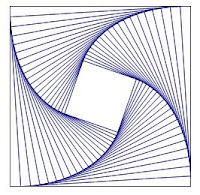Tuesday, November 3, 2009
The Calculus of Friendship - a review
In The Calculus of Friendship, Steven Strogatz, a Professor of Mathematics at Cornell, gives us a memoir of the friendship he has maintained with his former high school teacher, Don Joffray, as revealed through fragments of their 30 year correspondence. Their friendship was sparked and sustained through their shared enthusiasm for mathematics, and their long correspondence was, almost exclusively, framed by math problems.
The story of the correspondence between these two men is at once charming and subtly powerful. Strogatz writes directly and honestly, telling the story of a slow-growing friendship that was at once somewhat stilted and yet deep and sustaining. The immediacy and intimacy of Strogatz's writing transform the pleasures and tragedies of normal life into the elements of a compelling narrative, and because the book works so well on this human level, it also very effective in presenting some important lessons about education and about mathematics.
Joffray is presented as the kind of teacher who taught through encouragement and obvious enthusiasm. In many respects, Strogatz's book teaches in a similar manner. Never does Strogatz tell us unequivocally how mathematics should be taught, how we should think about mathematics, or what mathematics is all about. And yet, Strogatz provides us with some distinct impressions on all these questions, so that like the students in Joffray's classes, you leave having learned something important without realizing that you were being taught to.
What does the book tell us about mathematics education? Although Joffray and Strogatz taught and learned in a very privileged environment, the essential lessons of Joffray's teaching seem universal. A good teacher, we learn through Joffray's example, is humble, enthusiastic, respectful, and encouraging. Consider how these qualities reveal themselves in a problem-oriented mathematics curriculum: problems are approached by both teachers and students as co-investigators, the successes of students are celebrated, rich problems are revisited again over time, and the teacher is rarely simply presenting results to passive students. Perhaps the most important quality that Joffray seems to embody is authenticity, and this, more than anything else, seems to have sustained him through his long career and won the admiration of his students. Here again, a subtle lesson - you have to be true to yourself, your instincts, and to what brings you enjoyment if you are going to succeed in education (or in life generally).
What does the book tell us about mathematics? Through the letters of Strogatz and Joffray, mathematics is revealed as a social activity, a language to express excitement and big ideas, and a subject whose growth is fueled by creative (and perhaps somewhat eccentric) enthusiasts who are compelled to do mathematics because of the pleasure it brings them. Strogatz seems always willing to return to the source of his original excitement about mathematics - solving interesting problems and sharing the excitement of discovery, while Joffray never gives up his own explorations and problem solving.
In their letters, Strogatz and Joffray touch on many interesting mathematical topics. Perhaps because he was writing to an enthusiast who was not engaged in "serious" research, much of what Strogatz wrote about in his letters are classics of recreational mathematics. The letters, and the additional references provided at the end of the book, provide many starting points for learning about these topics. Among other things, Stogatz and Joffray discussed pursuit problems (see the MathWorld entry here for an overview and some nice animations) the Monty Hall problem (see this post), and a geometric proof of the irrationality of the square root of two (see "proof 7" at Cut-the-Knot's list of 19 proofs).
One problem that was new to me was the "monk and the mountain" problem, which is related to a whole family of intermediate value and fixed point theorems. Charles Wells has written several interesting posts on the monk and the mountain problem (a recent one here, and another here), explaining how it exemplifies a class of problems that have "naive proofs." The proof that Wells presents is identical to the one that Strogatz describes, and at first it seems too lacking in rigor to be considered truly mathematical. Wells maintains, and I think that Strogatz would agree, that the proof, despite its naiveté, is still a solid mathematical proof. Naive proofs, like this one, have a special place in mathematics education - they can help broaden a learner's perception of what mathematics is and how it can be applied, show that good proofs cut through the unnecessary in order to get to the heart of why something is true, and remind us that mathematics often relies on metaphor in order to communicate its essential ideas.
The Calculus of Friendship is an accessible, engaging, and useful book. Strogatz has taken an engaging personal story and through it has taught some important lessons about friendship, teaching, and mathematics.
The images in this post are from a GSP iteration (file here) that I was reminded of while reading Strogatz's description of a pursuit problem involving 4 dogs chasing each other from the corners of a square.
Labels:
book review,
education,
math,
school math


